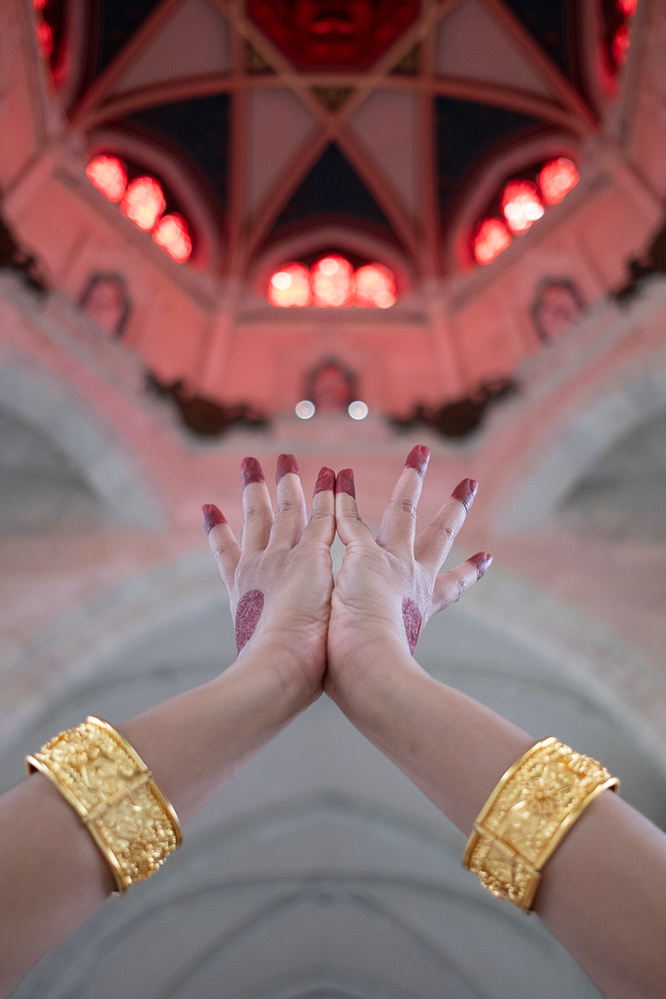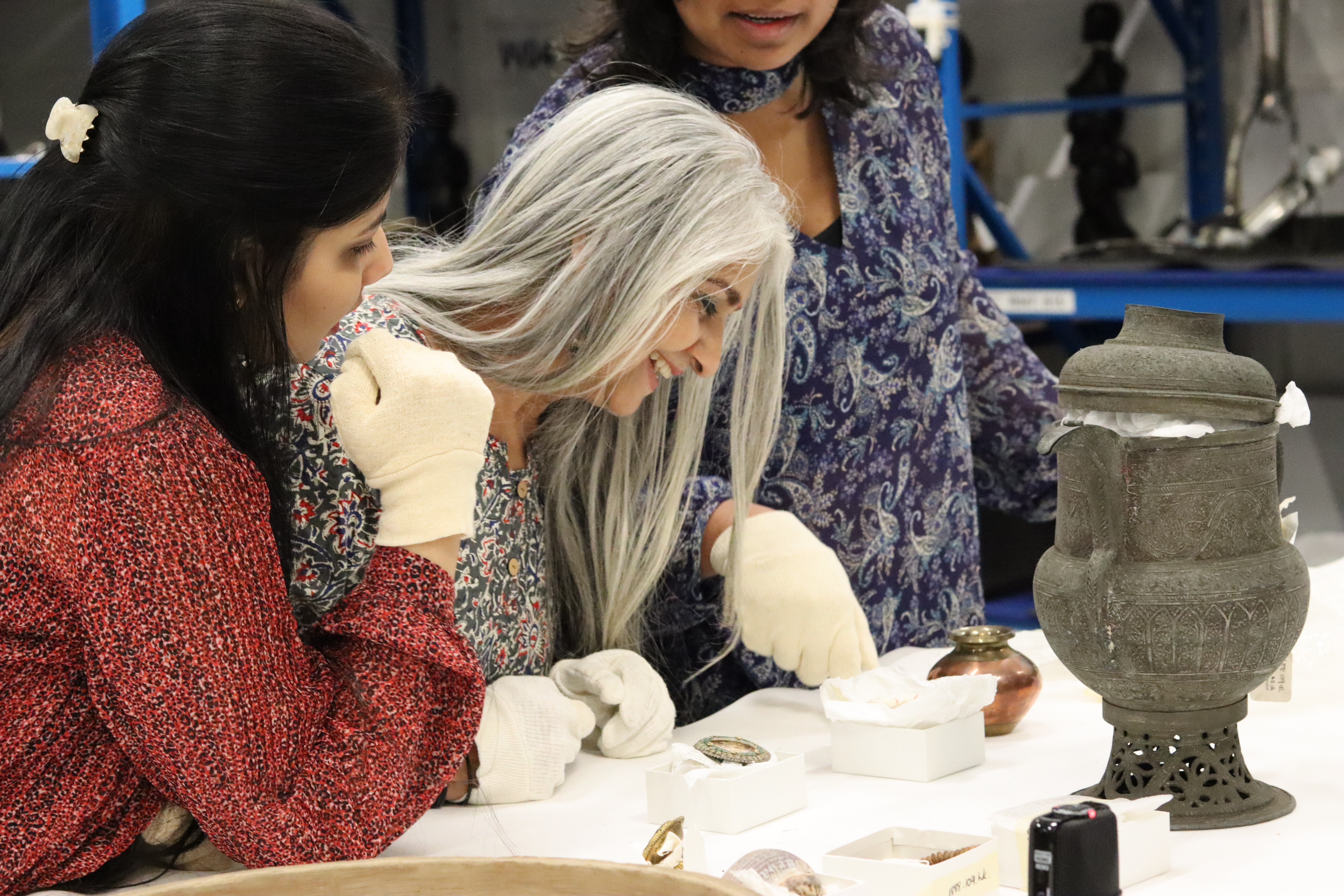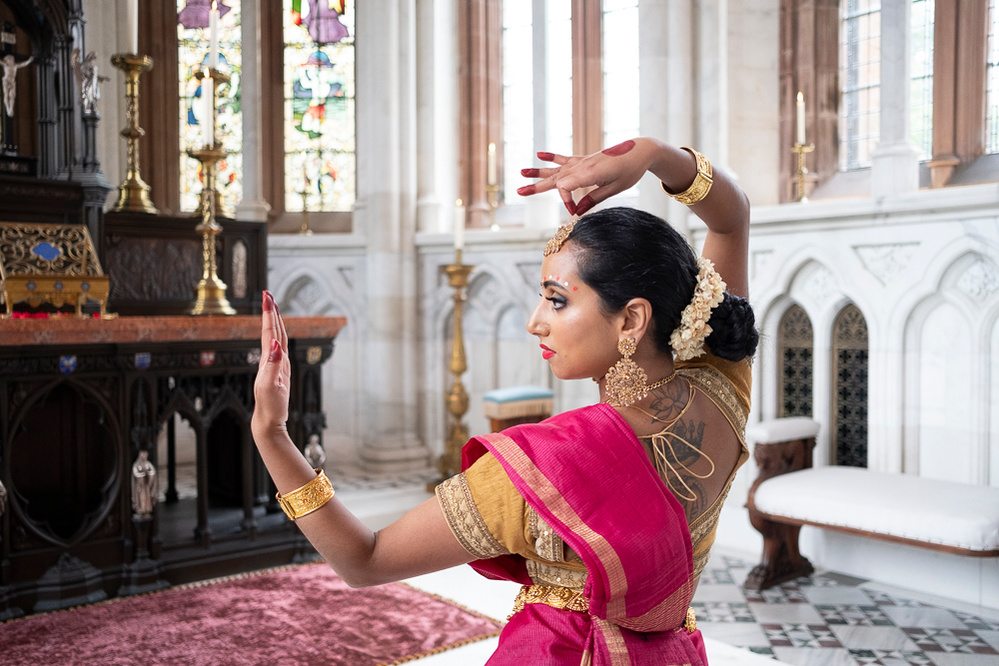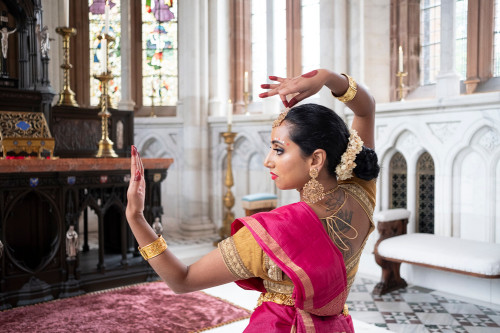
Anam Ki Almari Behind the Scenes Still, photo credit: Miriam Ali
Aqsa Arif is a Scottish-Pakistani artist who uses the interdisciplinary mediums of film, printmaking, photography and poetry to construct installations in which she explores the themes of dual heritage, migration and cultural dissonance. Her practice is deeply inspired by narrative structures built within folklore, mythology and cinematic spaces, exploring this through her own dual identity and displacement to reclaim and re-imagine the pre/post-colonial world. She delves into these difficult themes through the lens of fictional world building as a safe realm for expression, using characters and avatars to immerse the audience within the unconscious, the uncomfortable and the disparate.

Anam Ki Almari Behind the Scenes Still, photo credit: Miriam Ali
Arif has been the 20/20 artist-in-residence at Kelvingrove since August 2022. Anam Ki Almari presents the culmination of her research into Glasgow Museums’ collection as a film installation and ceramic works. This new work creatively re-appropriates the objects collected from the Glasgow International Exhibition (1888) – more specifically the ‘Indian Pavilion’ – exploring rituals, traditions and the communal act of making as a way to overcome subjugation and reclaim the colonial gaze.

Anam Ki Almari, film still, 2023, image courtesy of the Artist
Anam Ki Almari, represents Arif’s most substantial undertaking to date. Throughout the research and development, she fostered collaborations with South Asian community groups in Glasgow. These included the Glendale Women’s Café, Glasgow Sitare and the young changemakers from Our Shared Cultural Heritage within Kelvingrove. She invited them to the Glasgow Museums Resource Centre to handle the selected objects from her research and share stories through oral storytelling, hand building clay and singing workshops. The collaborations have been an integral part of how the work developed and were a cathartic way for Arif herself to uncover the very human narratives behind these ornamental objects.
-

Glendale Womens’ Cafe Object Handling, photo credit: Katie Bruce -

Anam Ki Almari, film still, 2023, image courtesy of the Artist
The performers in the film embody some of these objects that Arif found in the collection. These objects – represented in human form – revitalise rich South Asian customs and heritage, resisting their portrayal as mere souvenirs from the British Empire. Through the presence of performers, she reminds us that it was more than just the appropriation of an object and its history. The severity of the damage and confusion caused through colonialism was on a human level. By shedding light on the hidden histories, the work recontextualizes Glasgow's colonial legacy and the South Asian heritage within the British Empire.

Anam Ki Almari Behind the Scenes Still, photo credit: Miriam Ali
Partner Reflection
Glasgow Life Museums
Katie Bruce, Producer/Curator
Nelson Cummins, Curator (Legacies of Slavery and Empire)
Phillipa MacInnes, Museum Manager for Kelvingrove Art Gallery and Museum, St Mungo Museum of Religious Life and Art and Provand’s Lordship
Kelvingrove Art Gallery and Museum hosted Aqsa Arif for the 20/20 residency and displayed Anam Ki Almari (The Trophy Cupboard) and Ghar Ke Khazaneh (Home Treasures) (both 2023) at the museum from 2 November 2023 – 8 July 2024. We also worked with Aqsa to realise the acquisition of this work alongside other recent acquisitions for Glasgow Museums by BIPOC artists from different generations in Scotland.
Aqsa Arif’s 20/20 residency is part of broader work at Kelvingrove and wider Glasgow Museums venues as part of a commitment made by the Head of Museums and Senior Management Team to anti-racist and decolonial practices. The current programme at Kelvingrove was initiated by Miles Greenwood in 2020 and is continuing with Nelson Cummins from March 2023 in their capacity as Curator (Legacies of Empire and Slavery), alongside other colleagues. As a curatorial and museums management team we are pro-actively discussing racism, anti-racist practice, histories of empire and slavery present across our collections, and how we address this visibly in venues, databases, collecting activity and online materials. This discussion and work have not been limited to curatorial, learning and research teams. The Kelvingrove team organised briefings for front-of-house staff and shop, café, cleaning and technical staff about the display of Aqsa’s work, alongside the semi-permanent display co-curated by Our Shared Cultural Heritage Changemakers, called Glasgow: City of Empire. This wider staff group is also being supported to undertake their own learning through further and ongoing professional development via tailored training and investment in a staff library.
There were some continuity challenges for Aqsa with the change of staff (both curatorial and managerial at Kelvingrove) but Aqsa navigated the difficulties and achieved this exhibition despite changing staff support and stretched museum resources within a local authority. In the original residency outline there was not a presumption that there would be a physical display. However, through the change of Museum Manager and the development of Aqsa’s work, a space was identified within the museum ensuring it could be supported and profiled in the venue and enabling the influence of the work to reach a wider audience.
In the short-term, Anam Ki Almari raises questions about the museum and the nearby exhibition display that inspired it. The strong decolonial, anti-racist narrative running through the film has informed other planned work on displays at Kelvingrove and other venues. The curatorial team at Kelvingrove has used Aqsa’s display, alongside City of Empire, to facilitate visits and discussions on anti-racist practice with internal staff groups and wider community groups and partners, with Aqsa’s display playing a key role in sparking discussions and reflections on institutional change.
As it becomes part of Glasgow Museums’ collection, the long-term ambition of the artist is for the work to continue to be a catalyst for change from within. This supports us as a museum service actively exploring how we sustain interventionist practices and use opportunities for display changes and exhibitions to expand the stories that our objects can tell with a less white, western-centric perspective.
